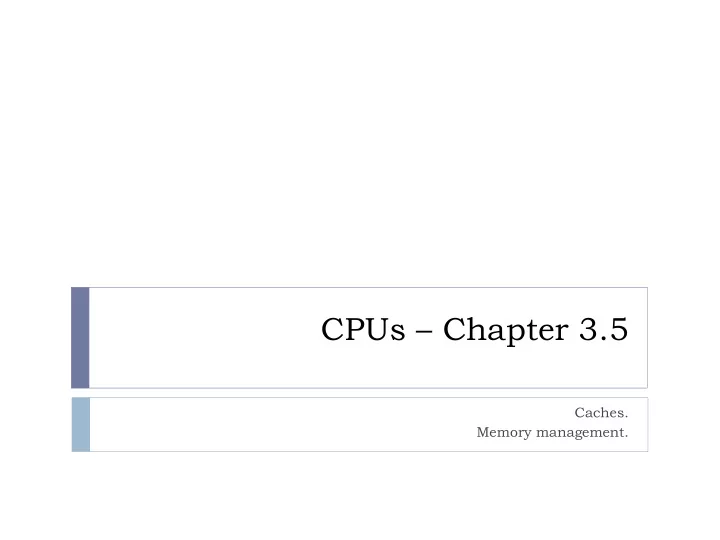

CPUs – Chapter 3.5 Caches. Memory management.
Caches and CPUs address data cache controller cache main CPU memory address data data
ARM Cortex-A9 Configurations
ARM Cortex A9 Microarchitecture Main System Memory
ARM Cortex-A9 MPCore
Cache operation Many main memory locations are mapped onto one cache entry. May have caches for: instructions; data; data + instructions (unified). Memory access time is no longer deterministic. Depends on “hits” and “misses” Cache hit: required location is in cache. Cache miss: required location is not in cache. Working set: set of locations used by program in a time interval. Anticipate what is needed to minimizes misses
Types of misses Compulsory (cold): location has never been accessed. Capacity: working set is too large. Conflict: multiple locations in working set map to same cache entry – fighting for the same cache location Cache miss penalty: added time due to a cache miss.
Cache performance benefits Keep frequently-accessed locations in fast cache. Cache retrieves multiple words at a time from main memory. Sequential accesses are faster after first access.
Memory system performance h = cache hit rate; (1-h) = cache miss rate t cache = cache access time t main = main memory access time Average memory access time: look-through cache t av = ht cache + (1-h)(t cache +t main ) look-aside cache t av = ht cache + (1-h)t main
Multiple levels of cache CPU L1 cache L2 cache h 1 = cache hit rate. h 2 = rate for miss on L1, hit on L2. Average memory access time: t av = h 1 t L1 + (h 2 -h 1 )t L2 + (1- h 2 -h 1 )t main
Write operations Write-through: immediately copy write to main memory. Write-back: write to main memory only when location is removed from cache.
Replacement policies Replacement policy: strategy for choosing which cache entry to throw out to make room for a new memory location. Two popular strategies: Random. Least-recently used (LRU).
Cache organizations Fully-associative: any memory location can be stored anywhere in the cache (almost never implemented). Direct-mapped: each memory location maps onto exactly one cache entry. N-way set-associative: each memory location can go into one of n sets.
Direct-mapped cache locations Many locations map onto the same cache block. Conflict misses are easy to generate: Array a[ ] uses locations 0, 1, 2, … Array b[ ] uses loc’s 0x400, 0x401, 0x402, … Operation a[i] + b[i] generates conflict misses. MAIN CACHE a[ 0 ] Index P Tag Data 0x000 a[ 1 ] 0x001 a[ 0 ] 1 0x00 0 b[ 1 ] 1 0x01 4 0 0 Index 0 b[ 0 ] 0x400 0 0xFF b[ 1 ] 0x401 Tag = Address: 0x401 Hit? 0xFFF
Set-associative cache A set of direct-mapped caches: Set 1 Set 2 Set n ... hit data
Example: direct-mapped vs. set-associative address data 000 0101 001 1111 010 0000 011 0110 100 1000 101 0001 110 1010 111 0100
Direct-mapped cache behavior After 001 access: After 010 access: block tag data block tag data 00 - - 00 - - 01 0 1111 01 0 1111 10 0 0000 10 - - 11 - - 11 - -
Direct-mapped cache behavior, cont’d. After 011 access: After 100 access: block tag data block tag data 00 1 1000 00 - - 01 0 1111 01 0 1111 10 0 0000 10 0 0000 11 0 0110 11 0 0110
Direct-mapped cache behavior, cont’d. After 101 access: After 111 access: block tag data block tag data 00 1 1000 00 1 1000 01 1 0001 01 1 0001 10 0 0000 10 0 0000 11 1 0100 11 0 0110
2-way set-associtive cache behavior Final state of cache (twice as big as direct-mapped): set blk 0 tag blk 0 data blk 1 tag blk 1 data 001 1000 - - 010 1111 1 0001 100 0000 - - 110 0110 1 0100
2-way set-associative cache behavior Final state of cache (same size as direct-mapped): set blk 0 tag blk 0 data blk 1 tag blk 1 data 0 01 0000 10 1000 1 10 0111 11 0100
ARM Cortex-A9 Configurations
Example caches StrongARM: 16 Kbyte, 32-way, 32-byte block instruction cache. 16 Kbyte, 32-way, 32-byte block data cache (write-back). C55x: Various models have 16KB, 24KB cache. Can be used as scratch pad memory.
Scratch pad memories Alternative to cache: Software determines what is stored in scratch pad. Provides predictable behavior at the cost of software control. C55x cache can be configured as scratch pad.
Memory management units (3.5.2) Memory management unit (MMU) translates addresses: memory main secondary management CPU memory storage unit logical physical swapping address address
Memory management tasks Allows programs to move in physical memory during execution. Allows virtual memory: memory images kept in secondary storage; images returned to main memory on demand during execution. Page fault: request for location not resident in memory.
Address translation Requires some sort of register/table to allow arbitrary mappings of logical to physical addresses. Two basic schemes: segmented; paged. Segmentation and paging can be combined (x86, PowerPC).
Segments and pages page 1 pages have fixed size page 2 segment 1 segments have memory arbitrary size fragmentation segment 2 of free memory
Segment address translation segment base address logical address + range segment lower bound range error segment upper bound check Also check physical address “protections”
Page address translation page offset page i base concatenate page offset
Page table organizations page descriptor page descriptor flat tree
Caching address translations Large translation tables require main memory access. TLB (translation lookaside buffer): cache for address translation. Typically small.
ARM memory management (optional) Memory region types: section: 1 Mbyte block; large page: 64 kbytes; small page: 4 kbytes. An address is marked as section-mapped or page- mapped. Two-level translation scheme.
ARM address translation Translation table 1st index 2nd index offset base register descriptor concatenate 1st level table concatenate descriptor 2nd level table physical address
Recommend
More recommend